tow Oldsmobile Silhouette 2004 Owner's Manuals
[x] Cancel search | Manufacturer: OLDSMOBILE, Model Year: 2004, Model line: Silhouette, Model: Oldsmobile Silhouette 2004Pages: 462, PDF Size: 3.1 MB
Page 1 of 462
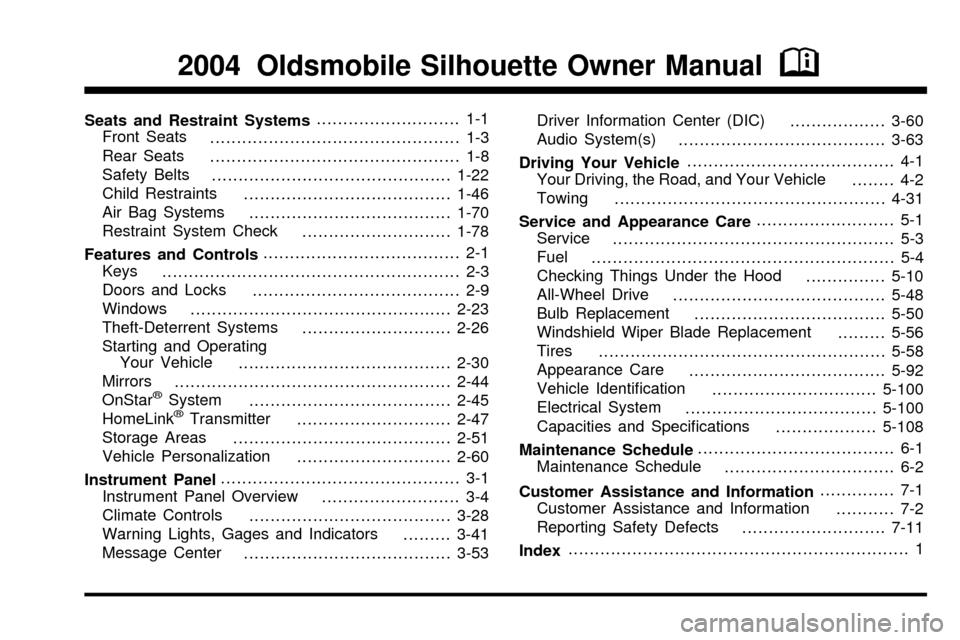
Seats and Restraint Systems........................... 1-1
Front Seats
............................................... 1-3
Rear Seats
............................................... 1-8
Safety Belts
.............................................1-22
Child Restraints
.......................................1-46
Air Bag Systems
......................................1-70
Restraint System Check
............................1-78
Features and Controls..................................... 2-1
Keys
........................................................ 2-3
Doors and Locks
....................................... 2-9
Windows
.................................................2-23
Theft-Deterrent Systems
............................2-26
Starting and Operating
Your Vehicle
........................................2-30
Mirrors
....................................................2-44
OnStar
žSystem
......................................2-45
HomeLinkžTransmitter
.............................2-47
Storage Areas
.........................................2-51
Vehicle Personalization
.............................2-60
Instrument Panel............................................. 3-1
Instrument Panel Overview
.......................... 3-4
Climate Controls
......................................3-28
Warning Lights, Gages and Indicators
.........3-41
Message Center
.......................................3-53Driver Information Center (DIC)
..................3-60
Audio System(s)
.......................................3-63
Driving Your Vehicle....................................... 4-1
Your Driving, the Road, and Your Vehicle
........ 4-2
Towing
...................................................4-31
Service and Appearance Care.......................... 5-1
Service
..................................................... 5-3
Fuel
......................................................... 5-4
Checking Things Under the Hood
...............5-10
All-Wheel Drive
........................................5-48
Bulb Replacement
....................................5-50
Windshield Wiper Blade Replacement
.........5-56
Tires
......................................................5-58
Appearance Care
.....................................5-92
Vehicle Identi®cation
...............................5-100
Electrical System
....................................5-100
Capacities and Speci®cations
...................5-108
Maintenance Schedule..................................... 6-1
Maintenance Schedule
................................ 6-2
Customer Assistance and Information.............. 7-1
Customer Assistance and Information
........... 7-2
Reporting Safety Defects
...........................7-11
Index................................................................ 1
2004 Oldsmobile Silhouette Owner ManualM
Page 7 of 462
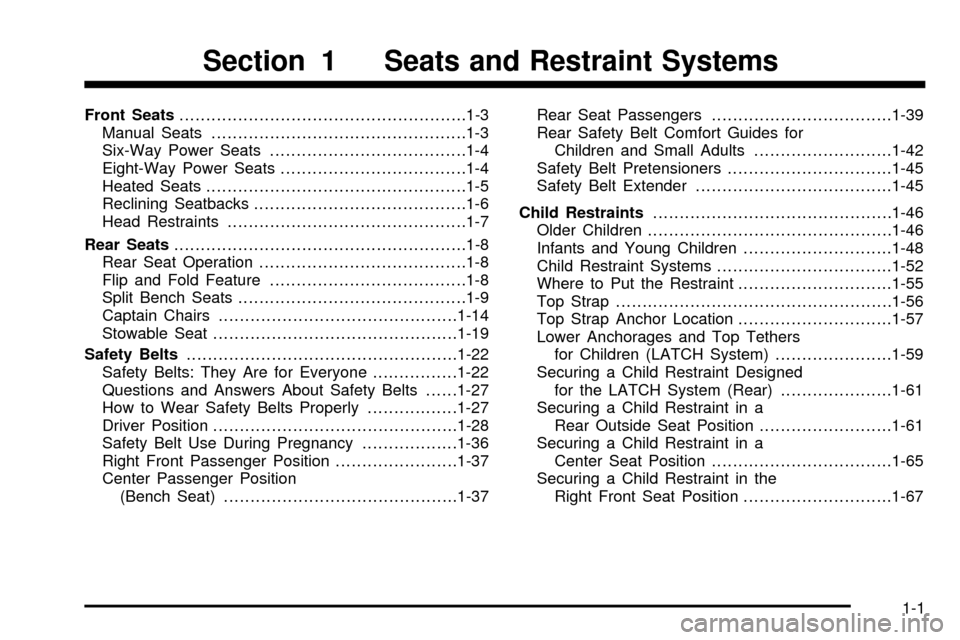
Front Seats......................................................1-3
Manual Seats................................................1-3
Six-Way Power Seats.....................................1-4
Eight-Way Power Seats...................................1-4
Heated Seats.................................................1-5
Reclining Seatbacks........................................1-6
Head Restraints.............................................1-7
Rear Seats.......................................................1-8
Rear Seat Operation.......................................1-8
Flip and Fold Feature.....................................1-8
Split Bench Seats...........................................1-9
Captain Chairs.............................................1-14
Stowable Seat..............................................1-19
Safety Belts...................................................1-22
Safety Belts: They Are for Everyone................1-22
Questions and Answers About Safety Belts......1-27
How to Wear Safety Belts Properly.................1-27
Driver Position..............................................1-28
Safety Belt Use During Pregnancy..................1-36
Right Front Passenger Position.......................1-37
Center Passenger Position
(Bench Seat)............................................1-37Rear Seat Passengers..................................1-39
Rear Safety Belt Comfort Guides for
Children and Small Adults..........................1-42
Safety Belt Pretensioners...............................1-45
Safety Belt Extender.....................................1-45
Child Restraints.............................................1-46
Older Children..............................................1-46
Infants and Young Children............................1-48
Child Restraint Systems.................................1-52
Where to Put the Restraint.............................1-55
Top Strap....................................................1-56
Top Strap Anchor Location.............................1-57
Lower Anchorages and Top Tethers
for Children (LATCH System)......................1-59
Securing a Child Restraint Designed
for the LATCH System (Rear).....................1-61
Securing a Child Restraint in a
Rear Outside Seat Position.........................1-61
Securing a Child Restraint in a
Center Seat Position..................................1-65
Securing a Child Restraint in the
Right Front Seat Position............................1-67
Section 1 Seats and Restraint Systems
1-1
Page 10 of 462
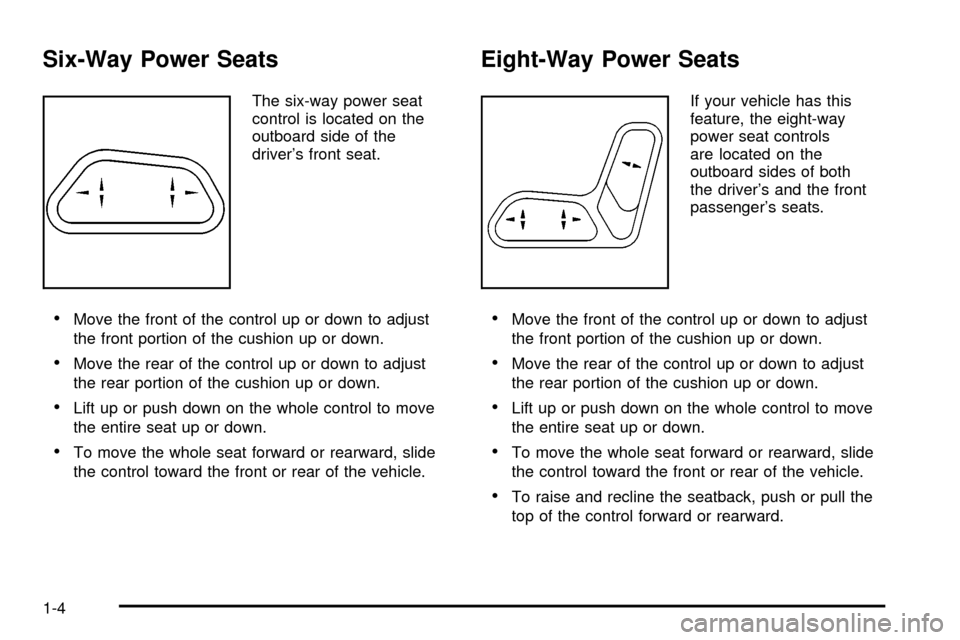
Six-Way Power Seats
The six-way power seat
control is located on the
outboard side of the
driver's front seat.
·Move the front of the control up or down to adjust
the front portion of the cushion up or down.
·Move the rear of the control up or down to adjust
the rear portion of the cushion up or down.
·Lift up or push down on the whole control to move
the entire seat up or down.
·To move the whole seat forward or rearward, slide
the control toward the front or rear of the vehicle.
Eight-Way Power Seats
If your vehicle has this
feature, the eight-way
power seat controls
are located on the
outboard sides of both
the driver's and the front
passenger's seats.
·Move the front of the control up or down to adjust
the front portion of the cushion up or down.
·Move the rear of the control up or down to adjust
the rear portion of the cushion up or down.
·Lift up or push down on the whole control to move
the entire seat up or down.
·To move the whole seat forward or rearward, slide
the control toward the front or rear of the vehicle.
·To raise and recline the seatback, push or pull the
top of the control forward or rearward.
1-4
Page 16 of 462
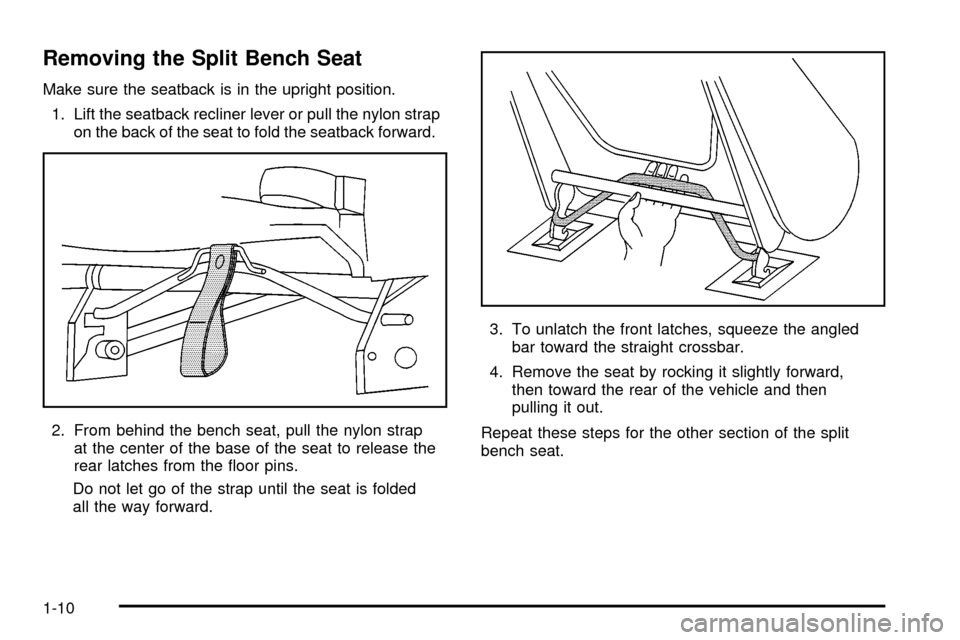
Removing the Split Bench Seat
Make sure the seatback is in the upright position.
1. Lift the seatback recliner lever or pull the nylon strap
on the back of the seat to fold the seatback forward.
2. From behind the bench seat, pull the nylon strap
at the center of the base of the seat to release the
rear latches from the ¯oor pins.
Do not let go of the strap until the seat is folded
all the way forward.3. To unlatch the front latches, squeeze the angled
bar toward the straight crossbar.
4. Remove the seat by rocking it slightly forward,
then toward the rear of the vehicle and then
pulling it out.
Repeat these steps for the other section of the split
bench seat.
1-10
Page 18 of 462
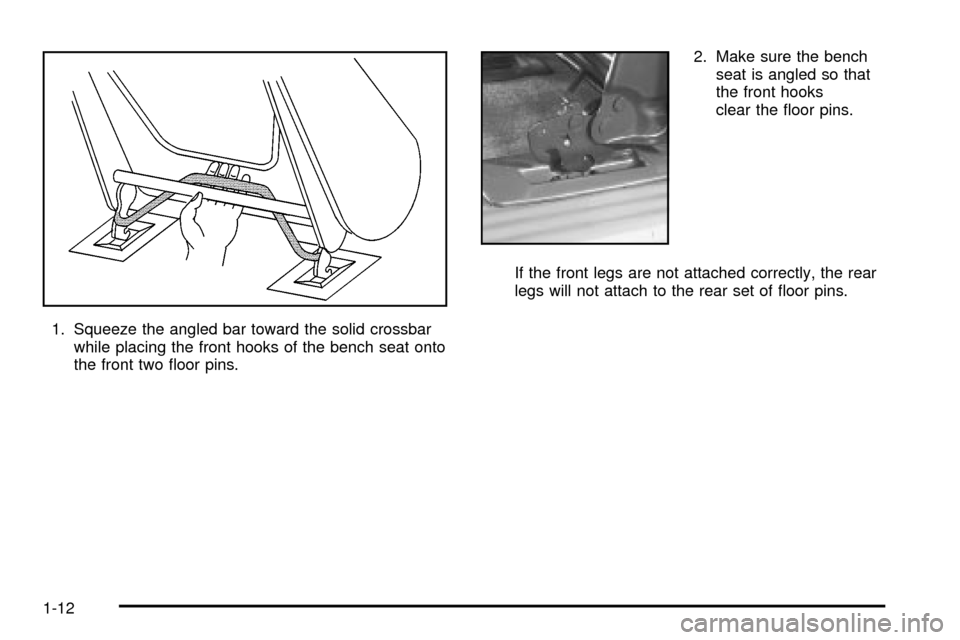
1. Squeeze the angled bar toward the solid crossbar
while placing the front hooks of the bench seat onto
the front two ¯oor pins.2. Make sure the bench
seat is angled so that
the front hooks
clear the ¯oor pins.
If the front legs are not attached correctly, the rear
legs will not attach to the rear set of ¯oor pins.
1-12
Page 25 of 462
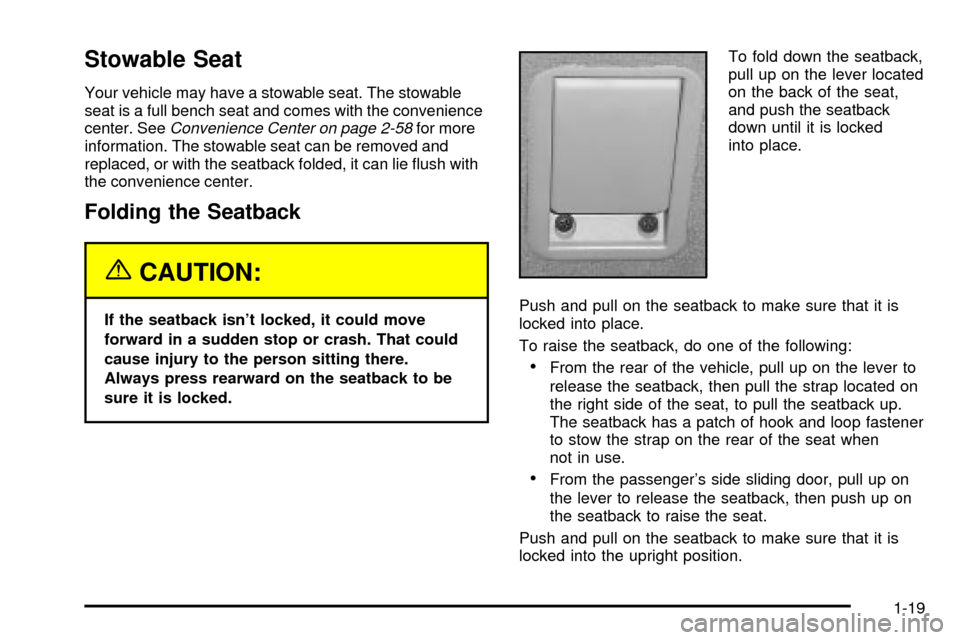
Stowable Seat
Your vehicle may have a stowable seat. The stowable
seat is a full bench seat and comes with the convenience
center. See
Convenience Center on page 2-58for more
information. The stowable seat can be removed and
replaced, or with the seatback folded, it can lie ¯ush with
the convenience center.
Folding the Seatback
{CAUTION:
If the seatback isn't locked, it could move
forward in a sudden stop or crash. That could
cause injury to the person sitting there.
Always press rearward on the seatback to be
sure it is locked.To fold down the seatback,
pull up on the lever located
on the back of the seat,
and push the seatback
down until it is locked
into place.
Push and pull on the seatback to make sure that it is
locked into place.
To raise the seatback, do one of the following:
·From the rear of the vehicle, pull up on the lever to
release the seatback, then pull the strap located on
the right side of the seat, to pull the seatback up.
The seatback has a patch of hook and loop fastener
to stow the strap on the rear of the seat when
not in use.
·From the passenger's side sliding door, pull up on
the lever to release the seatback, then push up on
the seatback to raise the seat.
Push and pull on the seatback to make sure that it is
locked into the upright position.
1-19
Page 26 of 462
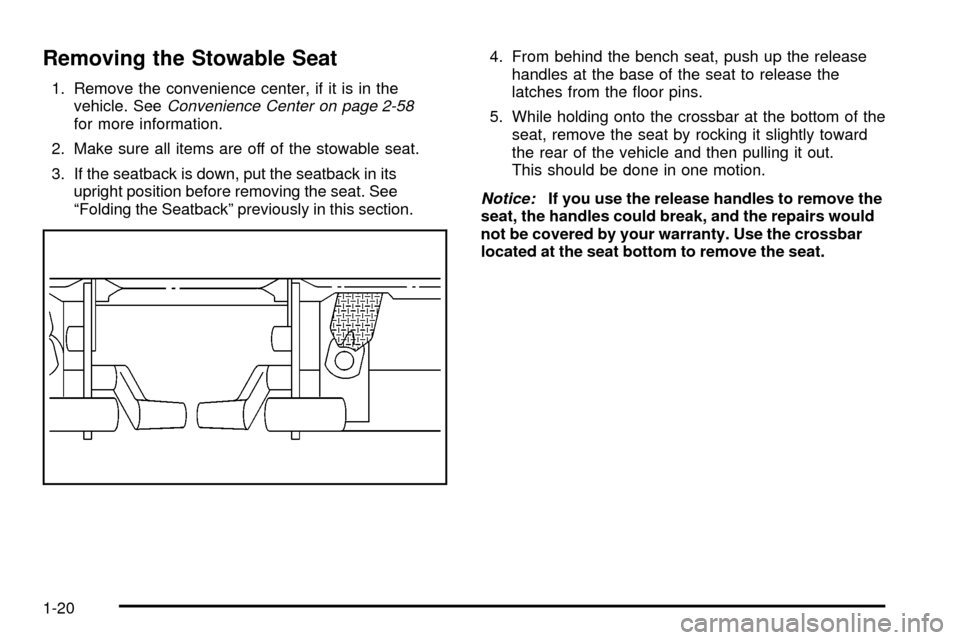
Removing the Stowable Seat
1. Remove the convenience center, if it is in the
vehicle. SeeConvenience Center on page 2-58for more information.
2. Make sure all items are off of the stowable seat.
3. If the seatback is down, put the seatback in its
upright position before removing the seat. See
ªFolding the Seatbackº previously in this section.4. From behind the bench seat, push up the release
handles at the base of the seat to release the
latches from the ¯oor pins.
5. While holding onto the crossbar at the bottom of the
seat, remove the seat by rocking it slightly toward
the rear of the vehicle and then pulling it out.
This should be done in one motion.
Notice:If you use the release handles to remove the
seat, the handles could break, and the repairs would
not be covered by your warranty. Use the crossbar
located at the seat bottom to remove the seat.
1-20
Page 27 of 462
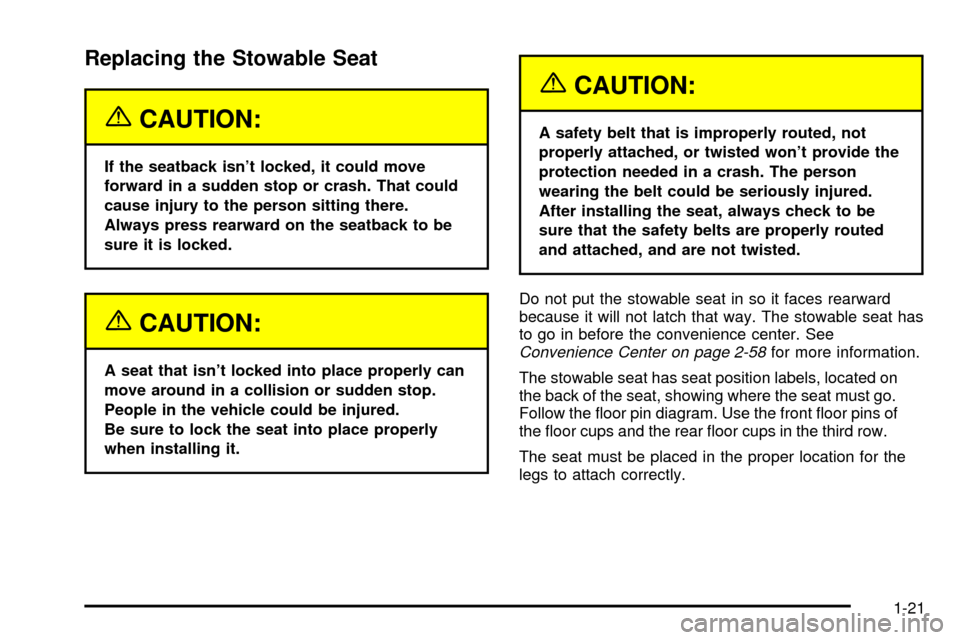
Replacing the Stowable Seat
{CAUTION:
If the seatback isn't locked, it could move
forward in a sudden stop or crash. That could
cause injury to the person sitting there.
Always press rearward on the seatback to be
sure it is locked.
{CAUTION:
A seat that isn't locked into place properly can
move around in a collision or sudden stop.
People in the vehicle could be injured.
Be sure to lock the seat into place properly
when installing it.
{CAUTION:
A safety belt that is improperly routed, not
properly attached, or twisted won't provide the
protection needed in a crash. The person
wearing the belt could be seriously injured.
After installing the seat, always check to be
sure that the safety belts are properly routed
and attached, and are not twisted.
Do not put the stowable seat in so it faces rearward
because it will not latch that way. The stowable seat has
to go in before the convenience center. See
Convenience Center on page 2-58for more information.
The stowable seat has seat position labels, located on
the back of the seat, showing where the seat must go.
Follow the ¯oor pin diagram. Use the front ¯oor pins of
the ¯oor cups and the rear ¯oor cups in the third row.
The seat must be placed in the proper location for the
legs to attach correctly.
1-21
Page 53 of 462
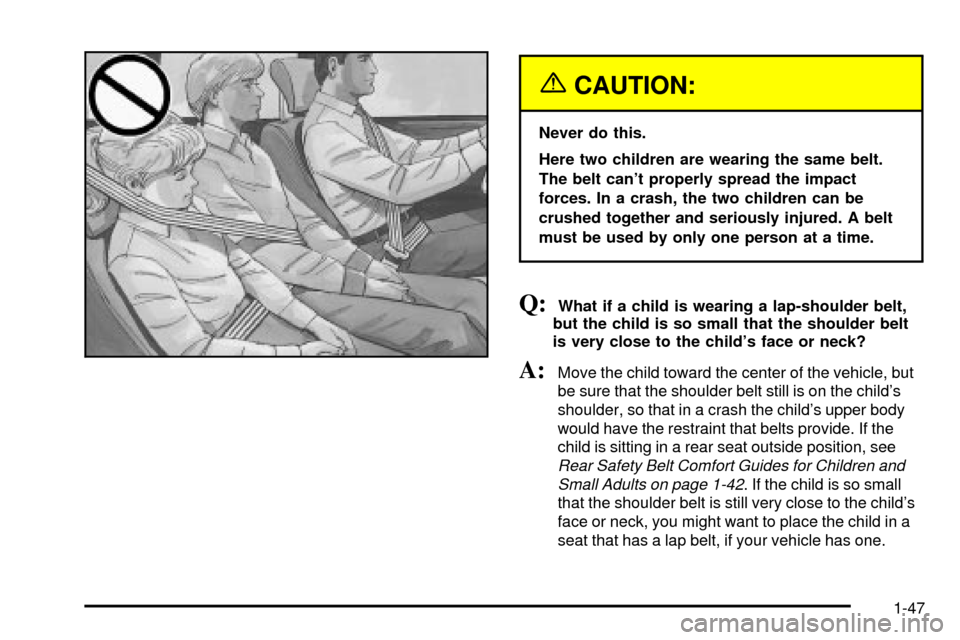
{CAUTION:
Never do this.
Here two children are wearing the same belt.
The belt can't properly spread the impact
forces. In a crash, the two children can be
crushed together and seriously injured. A belt
must be used by only one person at a time.
Q:What if a child is wearing a lap-shoulder belt,
but the child is so small that the shoulder belt
is very close to the child's face or neck?
A:Move the child toward the center of the vehicle, but
be sure that the shoulder belt still is on the child's
shoulder, so that in a crash the child's upper body
would have the restraint that belts provide. If the
child is sitting in a rear seat outside position, see
Rear Safety Belt Comfort Guides for Children and
Small Adults on page 1-42
. If the child is so small
that the shoulder belt is still very close to the child's
face or neck, you might want to place the child in a
seat that has a lap belt, if your vehicle has one.
1-47
Page 58 of 462

Child Restraint Systems
An infant car bed (A), a special bed made for use in
a motor vehicle, is an infant restraint system designed to
restrain or position a child on a continuous ¯at surface.
Make sure that the infant's head rests toward the
center of the vehicle.A rear-facing infant seat (B) provides restraint with
the seating surface against the back of the infant.
The harness system holds the infant in place and,
in a crash, acts to keep the infant positioned in
the restraint.
1-52